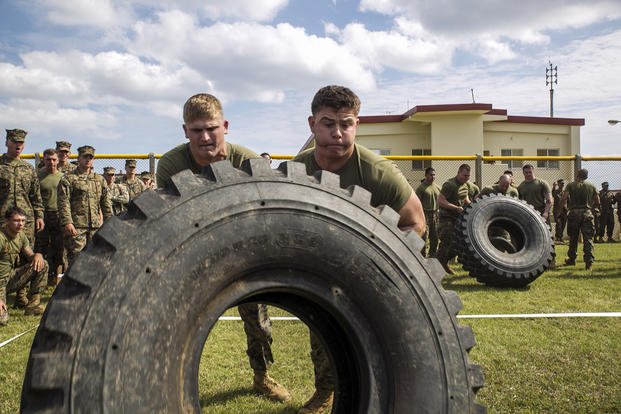This high-volume circuit is a great example of breaking a tough workout like the Murph into multiple, easier sub-maximum effort sets: one-mile run; 100 pull-ups, 200 push-ups and 300 squats; one-mile run.
This 20-set (super-set) circuit has added running sets to build up the interval and goal mile pace distances to a total of five miles.
Repeat 20 times
Pull-ups 5
Push-ups 10
Squats 15
Run a quarter-mile
*goal: 60-minute time limit
When complete, you will have accumulated (in the course of an hour or less, if you constantly keep moving) 100 pull-ups, 200 push-ups and 300 squats, along with 20 quarter-mile runs (a total of five miles).
It is up to you how fast you run those intervals. You can do them at your goal mile pace, or you can try to sprint (run faster than goal pace) for some of them. You may find that, as the volume of the repetition increases, maintaining your goal mile pace will be quite difficult. That's especially true if you are shooting for 1:30 or faster quarter-mile runs, which is a six-minute mile or faster.
Workouts like these can be monotonous, but they are great ways to build your ability to focus on something other than the dull pain and monotony. Believe it or not, you can achieve a state of meditative focus, which will enable you to dissociate from the tediousness of the workout. See recent article: Benefits of Meditation.
Additional swim PT workout: Once the run and the calisthenics are complete, add in a swimming workout if you have the energy or save it for later in the day.
Swim a 500-meter warmup, any stroke. The reason why we start off every swim workout with a 500-meter or 500-yard warmup is that typically most swim tests in the military/special ops/rescue swimmer world require a 500-meter or -yard distance (depending on the branch of service). This has physiological benefits to the swimmer and will help you get into better shape for future tests, but it also carries a psychological benefit in always calling 500 yards or 500 meters a "warmup."
After doing this for a few months of swim practices, when you take an official physical screening test (PST) or physical ability and stamina test (PAST) for the Navy or Air Force, respectively, you will be able to say, "OK, this is my warmup."
Repeat 10 times
Swim 50 fast freestyle at 8-10 strokes/breath
Swim 50-meter CSS or breaststroke (try minimal rest -- see whether the CSS is rest enough.)
Once you get good enough with the 10 sets of 50/50-meter swims, advance to the next level of 10 sets of 75/75-meter swims of the same combination of strokes. Once 100/100-meter sets for 5-10 sets are easy, you will find that you will be able to maintain your goal pace on the testing stroke required for your PST or PAST. But this takes time and effort. You should be swimming at least 1,000-1,500 meters a day (4-6 days a week) in order to get in shape for a fast and competitive 500-meter swim.
A good goal is a yard or meter per second. Focus on 500 seconds for your 500 test, and you will score an 8:20 swim time. This is competitive, and it is easy math to figure out if you are on pace at 100 or 200 yards, you should be at 100 or 200 seconds.
Stew Smith is a former Navy SEAL and fitness author certified as a Strength and Conditioning Specialist (CSCS) with the National Strength and Conditioning Association. Visit his Fitness eBook store if you’re looking to start a workout program to create a healthy lifestyle. Send your fitness questions to stew@stewsmith.com.
Want to Learn More About Military Life?
Whether you're thinking of joining the military, looking for fitness and basic training tips, or keeping up with military life and benefits, Military.com has you covered. Subscribe to Military.com to have military news, updates and resources delivered directly to your inbox.














